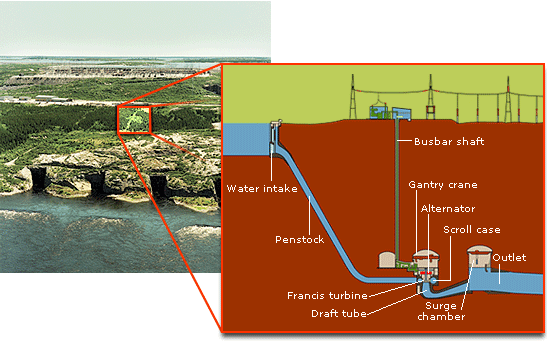Generating Station
- Find out more!
 Hydro-Québec's generating facilities
Hydro-Québec's generating facilities
- Find out more!
- Safety regulations

A hydroelectric generating station is a plant that produces electricity by using water to propel the turbines, which, in turn, drive the generators.
These power stations generate about a quarter of all the electricity used in the world. With 59 hydropower stations and access to vast water reserves, Hydro-Québec uses water to generate almost all of its energy output—98% in 2008. In this way, the company helps reduce greenhouse gas emissions.

Check out this interactive animation to see how hydropower is generated
Generating station with reservoir
A power station supplied by the water that accumulates in an artificial lake created by building a dam (retaining structure).

A head that's higher than the Eiffel Tower!
Sainte-Marguerite-3 generating station has a 330-metre head of water. That's 6 metres higher than the Eiffel Tower, antenna included.
Robert-Bourassa, an underground generating station with reservoir

 Surge chamber at Robert-Bourassa generating station
Surge chamber at Robert-Bourassa generating stationThis gigantic granite cavern acts mainly as a shock absorber for the strong variations in pressure which occur when turbines are started up or shut down. Water rises in the chamber rather than surging back toward the turbines and damaging them.
Run-of-river generating station
A power station fed directly by a river. It has little or no water storage capacity. Its head is usually not very high, so its generating output will depend on the flow of the river.
Carillon, a run-of-river generating station

 Robert-Bourassa, an underground generating station with reservoir
Robert-Bourassa, an underground generating station with reservoir Carillon, a run-of-river generating station
Carillon, a run-of-river generating station
